
A valley is an elongated low area often running between hills or mountains, which will typically contain a river or stream running from one end to the other. Most valleys are formed by erosion of the land surface by rivers or streams over a very long period. Some valleys are formed through erosion by glacial ice. These glaciers may remain present in valleys in high mountains or polar areas.
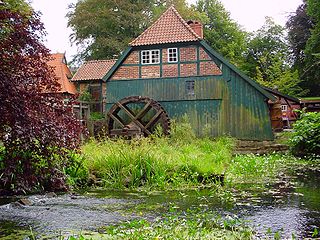
The river Bille is a small, slow-flowing German river in Stormarn, Schleswig-Holstein and Hamburg, a right tributary of the Elbe. Its source is near Linau, north of the heathland Hahnheide forest. It then flows south of Trittau, representing the border between Stormarn and Lauenburg, continues south of Reinbek and reaches the river Elbe near Billwerder. A lot of old estates and tasteful parks are laid out along its riverbank. Its total length is 65 km. Sections of the Bille which flow near or inside the Sachsenwald forest are protected by the Billetal nature reserve.

The Alster is a right tributary of the Elbe river in Northern Germany. It has its source near Henstedt-Ulzburg, Schleswig-Holstein, flows somewhat southwards through much of the Free and Hanseatic City of Hamburg and joins the Elbe in central Hamburg.

Binnenalster or Inner Alster Lake is one of two artificial lakes within the city limits of Hamburg, Germany, which are formed by the river Alster. The main annual festival is the Alstervergnügen.

Außenalster or Outer Alster Lake is the larger one of two artificial lakes, which are formed by the Alster River and are both located within the city limits of Hamburg, Germany. The other „lake“ is the Binnenalster. The Außenalster and its shores are used by the inhabitants of Hamburg for many sport and recreational purposes, such as sailing and rowing.
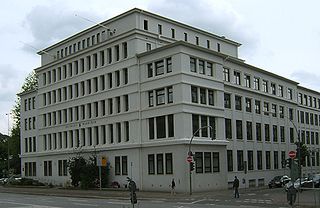
Wandsbek is the second-largest of seven boroughs that make up the city and state of Hamburg, Germany. The name of the district is derived from the river Wandse which passes through here. Wandsbek, which was formerly an independent city, is urban and, along with Eilbek and Marienthal, part of the city's economic and cultural core. In 2020 the population was 442,702, making it the most populous borough in Hamburg.

U-shaped valleys, also called trough valleys or glacial troughs, are formed by the process of glaciation. They are characteristic of mountain glaciation in particular. They have a characteristic U shape in cross-section, with steep, straight sides and a flat or rounded bottom. Glaciated valleys are formed when a glacier travels across and down a slope, carving the valley by the action of scouring. When the ice recedes or thaws, the valley remains, often littered with small boulders that were transported within the ice, called glacial till or glacial erratic.
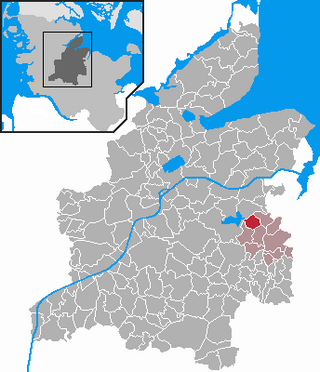
Rodenbek is a municipality in the district of Rendsburg-Eckernförde, in Schleswig-Holstein, Germany.

Poppenbüttel is a quarter in the borough Wandsbek of Hamburg, Germany. In 2020 the population was 24,135.

is a river flowing through Schleswig-Holstein and Hamburg, Germany.

Neustadt is one of the inner-city districts of the Free and Hanseatic City of Hamburg, Germany.
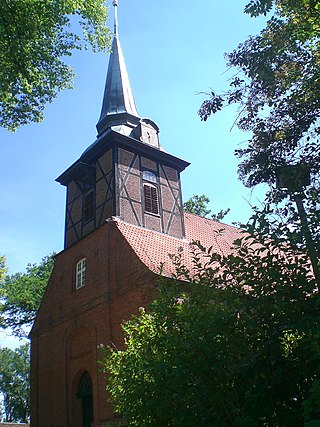
Bergstedt is a quarter of Hamburg, Germany, in the borough of Wandsbek. It is located on the northeastern border of the borough and of the city. It is part of the area of Walddörfer. In 2016 10,687 lived in Bergstedt.
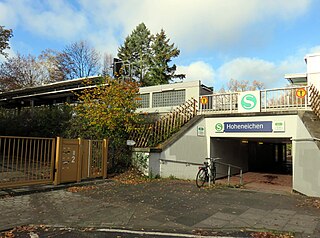
Hoheneichen is a station on the Alster Valley line, located in Wellingsbüttel, Hamburg, Germany. It is served by the trains of Hamburg S-Bahn lines S1 and S11. The station was opened in 1918.

Wellingsbüttel is a station on the Alster Valley line, located in Wellingsbüttel, Hamburg, Germany. It is served by the trains of Hamburg S-Bahn lines S1 and S11. The station was opened in 1918.

Isebekkanal is a canal in Hamburg, Germany. It has a length of about 3 km and is a remnant of the former stream of Isebek. The small Ottersbek stream flows into it. The Isebekkanal flows into the Alster.
Alster is a tributary of the Elbe river in Northern Germany.
Bredenbek is a municipality of Schleswig-Holstein, Germany.
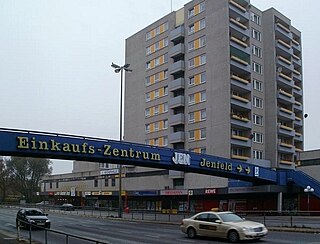
Jenfeld is a quarter of Hamburg, Germany in the Wandsbek borough.

Eidertal is an Amt in the district of Rendsburg-Eckernförde, in Schleswig-Holstein, Germany. It was created in June 2023 from the former Ämter Flintbek and Molfsee. The seat of the Amt is in Flintbek. The name refers to the valley of the river Eider.


















